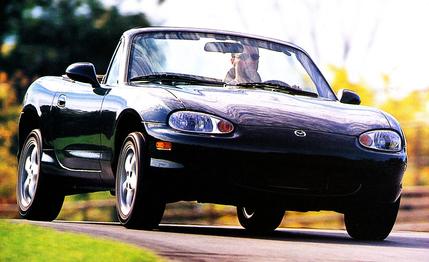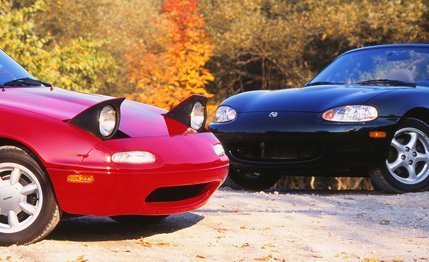
 Road Test
Road Test




Once upon a time, sports cars roamed the earth, and they were hyperhip. This journal was there, evangelizing to the faithful under a different banner—we were Sports Cars Illustrated back then. And our spare pages were heavy with fevered imaginings of sports cars of the future, all of which were exactly like this updated-for-1998 Miata, only not as good. Not as cute, either.
They were not as good because, hey, we weren't stupid. Our credibility would have been shot into doilies had we raised the bar this high on basic goodness. No one back then would have believed a sports car could have the "start every day till six digits show on the odometer" reliability that we take for granted today, along with ache-free seats, toasty heaters, and side glass that rises at the touch of a button.
Yet those imagined sports cars were to be exactly like this Miata—crazy fun to drive, frisky and zingy and quick to the touch. A sports car must have this essential zest, and the Miata captures it better than anything else on the road.
Whew. Take all this back-to-our-roots reminiscing as proof that this new Miata arouses all the right glands (if welcoming it onto our 10Best list this past January wasn't hint enough). For 1998, Mazda has gone back over the Miata it introduced for model year 1990, revising most details a little, but none of them very much, and—hurrah!—screwing up nothing.
Some changes are signs of the times. Hidden headlights were the fashion a decade ago, and the Miata had 'em. Now, cars have sparkling lenswork in front, and none are more alluring than the Miata's almond eyes (getting rid of the retractor gizmos saved 12 pounds, too). Toward the rear, we see "shoulders" over the tires now and a saucy little flare at the top of the tail. We like the overall shape better, and so does the airstream; the drag coefficient drops to 0.36 from 0.39. In a deft bit of aero tailoring, lift has been reduced in front and slightly increased at the rear, so that both ends of the car now lighten their tire loads at nearly the same rate as speed climbs; handling changes less with speed now.


Speed is another quality of sports cars that's changed beyond imagining over the years. In our SCI days, the affordable marques—the MGs, the Triumphs, the Fiats—topped out well under 100 mph. Now, the Miata is the only drop-top two-seater we'd put into the affordable class—about $24,000 here, with a heavy load of options. And it chases right up to a 123-mph top speed, 4 mph above our best first-generation Miata.
Displacement remains unchanged at 1840cc, but a new cylinder head lifts output by seven horsepower to 140; torque is up just over four percent. Both outputs peak at the same revs as before, and the 7000-rpm redline continues. This is very much a sports-car engine, with a torque curve that keeps rising till 5500 rpm. That late peak gives you a payoff for working the lever and keeping the revs raging.
Zero to 60 has dropped under 8.0 seconds now, to 7.9, compared with the 8.2-second clocking of our best previous Miata.


"So what?" some of us ask. Impressive acceleration numbers have never been the fun part of little top-down two-seaters. And top speed is purely academic. Call this the sensualist's view of sports cars. We love the tingle of revs and the snick of the shifter and the feel of a machine as it nears its limits, the slip-slide of the tires on the blacktop. These are joys SCI savored, and they're the forbidden fruit of today's powerful cars with their grippy tires. You can't treat yourself to much redline time when five or six seconds of flat-pedaling will punch through every speed limit in your state.
The "g" guys think differently. They measure their car fun according to the g meter, and more is better. The Miata, to most g guys, is a peashooter car without much appeal.
Except that this one has the optional Sport suspension with bright yellow Bilsteins and the 195/50VR-15 Pilot SX Michelins (Mazda says tire and suspension tuning of production cars may be slightly different from this preproduction test car). It clings to the skidpad up to 0.89 g and brakes down from 70 mph in only 174 feet. Those are pretty impressive numbers, enough to lift a peashooter into respected territory.